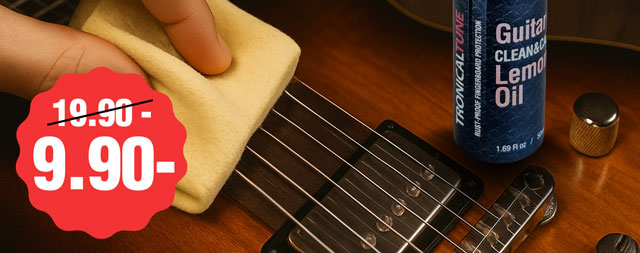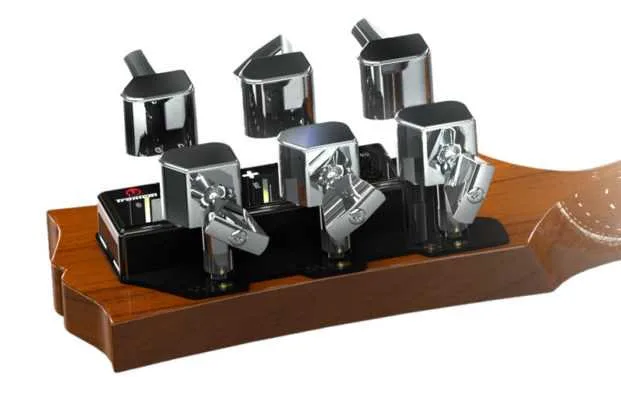Guitar Tuner, Chromatic Tuner, Guitar PolyTuner, Guitar Strings
Chromatic Tuner: What It Is, Why It Matters, and How to Get the Most from One
Chromatic Tuner “Nothing clears a room faster than an out‑of‑tune instrument.”
— Old Nashville proverb
Chromatic Tuner is the unsung ritual that separates a knock‑around rehearsal from a goosebump‑raising performance. Whether you’re polishing a studio take, ripping through a club set, or teaching a fresh crop of middle‑school band kids, accurate pitch is the one constant that makes every chord ring true. At the heart of that ritual sits the chromatic tuner—a pocket‑size oracle that hears every note, speaks every key, and, in the newest incarnations, can even twist your machine heads for you.
Table of Contents
1. The Birth of the Chromatic Tuner
Before LEDs and piezo sensors, tuning was part art, part compromise. Early 20th‑century orchestras relied on a pitch pipe or the oboe’s concert A. Guitarists lugged around fragile tuning forks set to 440 Hz and hoped the barroom heater didn’t skew the metal. The first electronic tuners emerged in the 1930s as bulky vacuum‑tube units the size of nightstands—great for broadcast engineers, useless for touring musicians.
Fast‑forward to the late ’70s: solid‑state components finally shrank the circuitry into something that could live beside your wah pedal. Yet these “needle meters” were still instrument‑specific, recognizing only E‑A‑D‑G‑B‑E for guitar or G‑D‑A‑E for violin. Drop‑tune your Strat to D or pick up a mandolin and the unit stared back blankly.
The chromatic revolution arrived in the late ’80s. Engineers realized that by analyzing frequency instead of preset notes, a single tuner could identify any pitch in the Western twelve‑tone scale. Suddenly one box served guitarists, bassists, horn players, and vocal coaches alike Chromatic Tuner. Affordable LCD screens showed note names; piezo clips bypassed crowd noise. The chromatic tuner was born—and stage life was never the same.
2. Chromatic vs. Guitar‑Only: Why the Distinction Matters
A guitar‑only tuner is hard‑wired to recognize six notes: E, A, D, G, B, and E. If you’re a strict standard‑tuning player, that limitation feels invisible. The moment you:
- drop the low E to D for grunge covers,
- capo the second fret for a folk set,
- or grab the banjo you promised to learn last New Year’s,
those older tuners throw up their hands. A chromatic tuner listens first, labels later. It hears an open C#3, G2 in baritone range, or the A440 from a clarinet and reports the nearest semitone plus the cents offset. That flexibility makes it indispensable for:
- Alternate tunings (DADGAD, open G, half‑step down)
- Multi‑instrumentalists playing ukulele at brunch and bass at midnight
- Teachers wrangling thirty beginner violins into something resembling a unison A
Bottom line: if you interact with any note outside E‑A‑D‑G‑B‑E, you need chromatic capability.
3. Anatomy of a Chromatic Tuner—How the Magic Happens
Every brand uses proprietary sauce, but under the hood most chromatic tuners share four fundamental blocks:
- Input Sensor
- Microphone for acoustic instruments and voice.
- Piezo clip for vibration isolation on noisy stages.
- ¼‑inch jack for electric guitars, pedals, or rack units.
- Pitch Detection Algorithm
The incoming waveform passes through a Fast Fourier Chromatic Tuner Transform (FFT) or autocorrelation engine to pinpoint fundamental frequency. High‑end strobe units use phase‑shift analysis for sub‑cent accuracy. - Reference Calibration Module
Default is A = 440 Hz, but orchestras may request 442 Hz; baroque ensembles dip to 415 Hz. Good tuners let you nudge ±5 Hz or more. - Display & Feedback Loop
Visuals range from LED “traffic lights” to sweeping LCD needles and spinning virtual strobes. Some pedals mute the output while you tune; clip‑ons flash color when you’re dead‑on.

The elegance lies in the feedback loop: sense → analyze → display → adjust → repeat. Done right, this loop completes in under 100 milliseconds—fast enough that your hand’s knob twist is the slowest link in the chain.
4. The Five Major Form Factors (and Who They Serve)
| Form Factor | Who Swears By It | Key Advantages | Trade‑Offs |
|---|---|---|---|
| Clip‑On | Singer‑songwriters, bluegrass jams, school orchestras | Mic + piezo duality; ignores crowd noise; improbably cheap | Screen glare in sunlight; easy to lose |
| Pedal | Electric guitarists, bassists, touring techs | Cuts the signal while tuning; buffers pedalboard; bright displays | Needs power; claims pedalboard real estate |
| Rack / Strobe | Studios, repair shops, backline rental houses | ±0.02‑cent accuracy; massive strobe wheel display; racklock security | Heavy; $300–$1,000 price tags |
| Mobile App | Hobbyists, travelers, casual jams | Always in pocket; zero cost entry | Mic bleed in loud venues; latency issues |
| Robotic Heads (TronicalTune) | Festival crews, pit musicians, fly‑date pros | Tunes in two seconds; stores 36 tunings; hands‑free | Adds weight to headstock; battery upkeep |
Selecting the “right” tuner depends less on genre and more on use‑case friction. A clip‑on wins acoustic green‑room battles where silence is golden. A pedal rules loud rock stages where you need to kill the front‑of‑house feed. A rack strobe is surgeon‑grade for intonation resets. And when every second counts, the robo‑head eats them all for breakfast.
5. Understanding Accuracy: Cents, Calibration, and Context
Accuracy in tuner‑speak is measured in cents, where 100 cents Chromatic Tuner equal one semitone. Human ears start noticing discord around 5–6 cents when two instruments play sustained notes in unison. In a full band mix, ±2–3 cents can hide behind cymbals; in a finger‑style acoustic duet, a 3‑cent mismatch feels like nails on slate.
Typical specs:
- Entry clip‑on: ±3 cents
- Pro pedal: ±1 cent
- Strobe rack: ±0.02 cent
- TronicalTune: ±1 cent (manufacturer spec)
Remember, a tuner’s spec is only half the equation; environmental noise, string condition, and player technique can introduce more error than the device itself. Tuning up from below pitch reduces backlash, but rusty tuners or a sticky nut can drag you back flat the moment you bend a note.
6. Ten Buying Factors You Won’t Find on the Box
- Display Lag: Refresh rate below 50 ms keeps the needle from “hunting.”
- True Bypass vs. Buffered Output: Long cable runs rob high‑end—buffered tuners return sparkle.
- Strobe Mode Option: Adds surgical accuracy for bridge setup without purchasing a rack unit.
- Reference Shift Range: Look for 415–465 Hz if you play Baroque gigs or drop track to a tape machine.
- Flat/Capo Steps: Automatic note offset up to four semitones speeds alt‑tuning sessions.
- Battery Type & Life: CR2032 clip‑ons last weeks; 9 V pedals die after a festival day if you leave them on.
- Mounting Hardware: Swivel joints and padded grips protect delicate headstocks.
- Screen Brightness & Color: High‑nit displays cut through LED walls; color coding saves eye strain.
- Durability: Metal jacks, silicone gaskets, and recessed buttons survive cargo holds.
- Firmware Updates: USB or Bluetooth upgrades future‑proof features and fix bugs.
7. Step‑by‑Step: Flawless Tuning for Every Scenario
Electric Guitar on a Loud Stage
- Mute via pedal switch.
- Check Reference (A = 440 Hz unless matching keyboard).
- Pluck Low E with moderate attack; let the meter settle.
- Tune Up to Pitch, never down.
- Repeat across strings; strum an E‑major chord; fine‑adjust if any string beats.
Acoustic Jam with a Clip‑On
- Attach Clip near the nut.
- Half‑Volume Pick the string; heavy hits overload piezo.
- Shade the Screen if sunlight washes LEDs.
- Stretch New Strings, then re‑check.
Classroom Full of Beginners
- Hand Out Clip‑Ons, all set to 440 Hz.
- Fret the Fifth on each kid’s instrument; have neighbors match Chromatic Tuner pitch—peer tuning accelerates ear training.
- Teacher Pass: walk row, spot‑check two strings per student, adjust as needed.
Using TronicalTune
- Press Power on the robo‑head.
- Strum Once, muting all unused strings with palm.
- Watch LEDs flash; motors turn each key to target.
- Green Light: done—about two seconds for standard tuning, three to five for complex alternates.
8. Beyond Standard: Alternate Tunings, Capos, and Temperaments
Alternate Tunings
Open‑G (D‑G‑D‑G‑B‑D) gives Keith Richards punch; DADGAD unlocks Celtic drones; baritone C‑standard rattles teeth in doom metal. A chromatic tuner lists every target pitch with no mental gymnastics. TronicalTune ups the game by storing up to 36 user presets—tap a button, strum, arrive in Drop‑C without guessing knob increments.
Capos
Capos transpose pitch but not tuner detection. Clip‑ons placed behind Chromatic Tuner the capo read open string names at the capoed fret, saving fretboard arithmetic, crucial for on‑the‑fly worship sets or Broadway pit gigs.
Temperaments and Sweetened Tunings
Certain rack and pedal tuners load presets like Buzz Feiten, James Taylor, or “sweetened” temperaments that slightly offset each string to smooth major‑third beating in equal temperament. These micro‑adjustments fall into ±2‑cent territory—plain‑text pedals can’t touch that, strobes and some firmware‑upgradable pedals can.
9. Troubleshooting and Maintenance Hacks
- Nut Bind: If you hear a “ping” during tuning, graphite‑lube those slots.
- Old Strings: Corroded windings produce inharmonic overtones; throw them out.
- Temperature Swings: Outdoor gigs Chromatic Tuner can shift pitch 4 cents per 10 °F; tune after sound‑check, again before downbeat.
- Battery Sag: LED brightness drop hints at voltage sag; replace before the encore.
- Cable Capacitance: Over 30 ft of unbuffered cable can attenuate Chromatic Tuner highs and foul tracking; use a buffered tuner or quality cable.
10. Myth‑Busting Speed vs. Precision—Enter TronicalTune
The old mantra reads: “Fast, cheap, accurate—pick two.” Early chromatic units indeed lagged: you’d pluck, wait, nudge, wait—repeat across six strings, burning 45 seconds. Pedal makers tightened accuracy to ±1 cent and sped refresh to 10 ms, yet human hand‑twisting remained the bottleneck.
TronicalTune flips the paradigm. By bolting motor‑driven machine heads to your guitar, it collapses the feedback loop into silicon. The piezo hears pitch, the chip computes offset, and the servo cranks the key in micro‑steps—all before your foot finds the mute pedal. Standard tuning completes in about two seconds; Drop‑D or open tunings in under five. Accuracy? ±1 cent—the same spec embossed on flagship pedals ten times slower.
For touring pros juggling multiple guitars or pit musicians navigating quick‑change set lists, that delta is game‑changing. You finish the last chord, toggle the preset, strum once, and step back into the score—all before the front‑of‑house engineer un‑mutes the vocal mic.
11. Real‑World Case Studies: Stage, Studio, and Classroom
Stage: The Festival Changeover
Jill, lead guitarist in an Americana quintet Chromatic Tuner, has 15 minutes to set up between bands. With a pedal tuner, she’d burn 30–40 seconds per guitar, three times per set. TronicalTune compresses that to six seconds total, letting her sound‑check pedalboard levels and in‑ears—tasks often skipped under time pressure.
Studio: Tight‑Take Syndrome
Producer Marcos tracks eight acoustic layers for a cinematic folk album. Slight pitch drift stacks dissonance, forcing re‑takes. Switching his rack strobe to strobe mode cures intonation, and a TronicalTune‑equipped dreadnought keeps subsequent takes within ±1 cent, reducing overdub bleed.
Classroom: Thirty Violins, One Instructor
Ms. Kim manages a middle‑school string orchestra. Before concerts, she used to walk row by row with a clip‑on, chewing up rehearsal time. Now she trains students to self‑tune with color‑coded clip‑ons set to 440 Hz, then spot‑checks two strings per player. The process drops from twenty minutes to eight, freeing time for phrasing and dynamics.
12. Peeking Ahead: The Future of Tuning Tech
- AI‑Enhanced Pitch Prediction: Machine learning may soon predict drift mid‑song, nudging robo‑heads silently between chords.
- Wearable Haptics: Smart rings that vibrate when a string wanders off pitch, ideal for deaf or hard‑of‑hearing performers.
- Integrated DSP in Instruments: Digital modeling guitars Chromatic Tuner could self‑correct pitch in software, blending autotune concepts with physical modeling.
- Eco‑Friendly Power: Solar strip clip‑ons and kinetic‑charge pedals reduce battery waste, aligning gear with green touring riders.
As processing power climbs and components miniaturize, expect tuning to move from a discrete prep step to a continuous, almost invisible background process.
13. Key Takeaways and Final Thoughts
- A chromatic tuner listens to every note in the twelve‑tone scale, making it indispensable for alternate tunings, multi‑instrumentalists, and educators.
- Accuracy specs matter, but context—stage volume, string age, technique—often dictates real‑world precision.
- Choosing the right form factor hinges on workflow friction: clip‑ons for silent pits, pedals for electric rigs, strobes for surgical setup, and TronicalTune for maximal speed.
- TronicalTune delivers the same ±1 cent accuracy as flagship chromatic pedals while slicing tuning time from 30–40 seconds to about two seconds—a critical gain in festival, pit, and studio settings.
- Tomorrow’s tuners will likely integrate AI prediction, haptic feedback, and eco‑power, but the core mantra remains: if your instrument isn’t in tune, nothing else you do will matter Chromatic Tuner.
Take these insights, stash a fresh battery in the gig bag, maybe splurge on the robo‑heads, and keep your music where it belongs—perfectly in tune, every single time.






